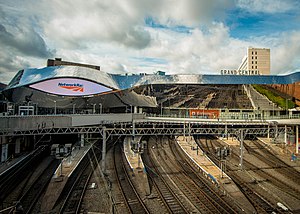
Back محطة بيرمينجام نيو ستريت ARZ Gorsaf reilffordd New Street Birmingham Welsh Bahnhof Birmingham New Street German ایستگاه نیو استریت بیرمنگام Persian Gare de Birmingham New Street French תחנת הרכבת ברמינגהאם ניו סטריט HE Birmingham New Street vasútállomás Hungarian Stazione di Birmingham New Street Italian バーミンガム・ニューストリート駅 Japanese Birmingham New Street geležinkelio stotis Lithuanian
 The east end of the station, with the newly rebuilt and refurbished building which opened in 2015. | |||||
| General information | |||||
| Location | Birmingham, West Midlands England | ||||
| Coordinates | 52°28′40″N 1°53′56″W / 52.47777°N 1.89885°W | ||||
| Grid reference | SP069866 | ||||
| Managed by | Network Rail | ||||
| Transit authority | Transport for West Midlands[1] | ||||
| Platforms | 13 (including 4C) | ||||
| Other information | |||||
| Station code | BHM | ||||
| Fare zone | 1 | ||||
| Classification | DfT category A | ||||
| History | |||||
| Original company | London & North Western Railway | ||||
| Key dates | |||||
| 1 June 1854 | First opened | ||||
| 8 February 1885 | Extension opened | ||||
| 1964–1967 | Rebuilt | ||||
| 2010–2015 | Redeveloped | ||||
| Passengers | |||||
| 2018/19 | |||||
| Interchange | | ||||
| 2019/20 | |||||
| Interchange | | ||||
| 2020/21 | |||||
| Interchange | | ||||
| 2021/22 | |||||
| Interchange | | ||||
| 2022/23 | |||||
| Interchange | | ||||
| |||||
| |||||
Birmingham New Street, also known as New Street station, is the largest and busiest of the three main railway stations in Birmingham city centre, England, and a central hub of the British railway system. It is a major destination for Avanti West Coast services from London Euston, Preston, Glasgow Central and Edinburgh Waverley and West Midlands Trains services from Liverpool Lime Street and London Euston both via the West Coast Main Line. The CrossCountry network centres on New Street, as well as local and suburban services within the West Midlands; these include those on the Cross-City Line between Lichfield Trent Valley, Redditch and Bromsgrove, and the Chase Line to Walsall and Rugeley Trent Valley. The three-letter station code is BHM.[2]
The station is named after New Street, which runs parallel to the station, although the station has never had a direct entrance from New Street except via the Grand Central shopping centre. Historically, the main entrance to the station was on Stephenson Street, just off New Street. As of 2022, the station has entrances on Stephenson Street, Smallbrook Queensway, Hill Street and Navigation Street.
New Street is the eleventh busiest railway station in the UK and the busiest outside London, with 30.7 million passenger entries and exits between April 2022 and March 2023. It is also the busiest interchange station outside London, with over 4 million passengers changing trains at the station annually. In 2018, New Street had a passenger satisfaction rating of 92%, the third highest in the UK.[3]
The original New Street station opened in 1854. At the time of its construction, the station had the largest single-span arched roof in the world.[4] In the 1960s, the station was completely rebuilt. An enclosed station, with buildings over most of its span and passenger numbers more than twice those it was designed for, the replacement was not popular with its users. A £550m redevelopment of the station named Gateway Plus opened in September 2015; it includes a new concourse, a new exterior facade and a new entrance on Stephenson Street.[5]
- ^ "West Midlands rail zones". Archived from the original on 19 January 2008. Retrieved 18 April 2020.
- ^ "Station information". Archived from the original on 13 August 2020. Retrieved 18 April 2020.
- ^ "Britain's 'best and worst' railway stations named". BBC News. London, UK. 7 May 2018. Archived from the original on 28 January 2019. Retrieved 23 December 2018.
- ^ "Birmingham New Street's 150-year history revealed as station switchover nears" (Press release). London, UK: Network Rail. 22 April 2013. Archived from the original on 2 February 2014. Retrieved 19 May 2013.
- ^ "Birmingham New Street update January 2013" (PDF). Jewellery Quarter Development Trust. Archived (PDF) from the original on 31 May 2013. Retrieved 8 February 2013.
© MMXXIII Rich X Search. We shall prevail. All rights reserved. Rich X Search
